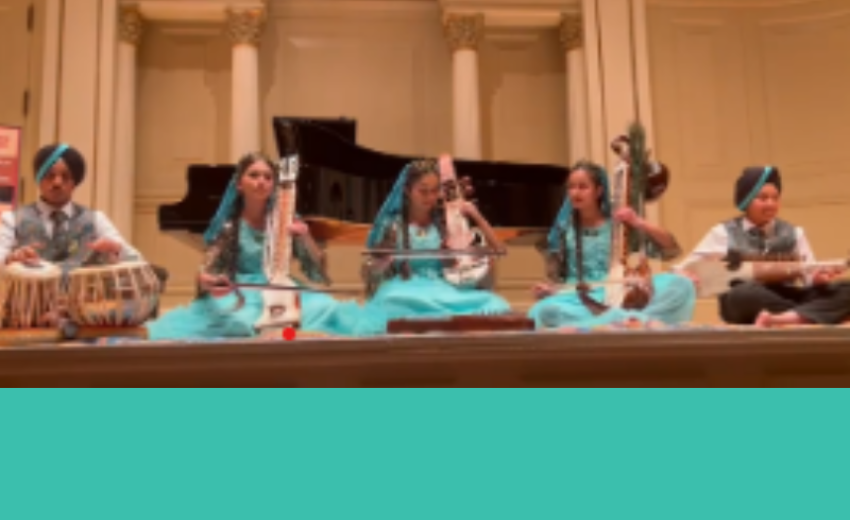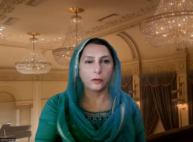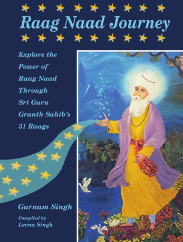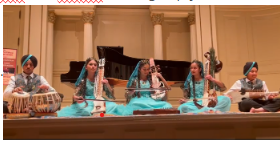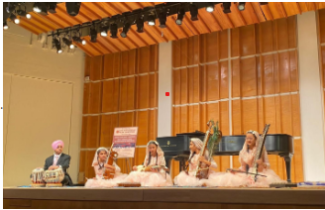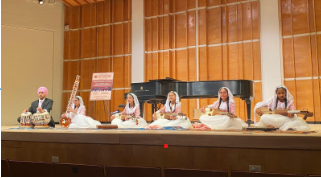The Sikh Heritage Symphony mesmerized audiences in New York City’s renowned Carnegie Hall and Merkin Hall with their performance using traditional Sikh heritage instruments, also called Tanti Saaz, in February. Musicians worldwide are becoming very interested in Sikh devotional music, as they are drawn to its soul-stirring melodies and rich array of ragas. These hymns flourish in the present day, thanks to the Sikhs who seamlessly weave them into their everyday existence, with the hymns resonating within every Gurdwara and echoing in every household on auspicious occasions. Musician Leena Singh and many others play an important role in fostering this cultural legacy and deserve resounding applause for their tireless efforts. The performance in New York City’s most prestigious halls and the warm reception nurtures continued exploration, education, and performance of the ragas enshrined within Sri Guru Granth Sahib Ji.
For the past 13 years, Leena Singh has been deeply engaged in the world of Gurbani Kirtan and Sikh music. In 2017, she founded the Sikh Heritage Symphony (SHS), providing a platform for Sikh families to enroll their talented children in Tanti Saaz learning programs. This initiative has garnered notable praise and support from Gurudwaras, including San Jose Gurudwara and Silicon Valley Gurudwara. San Jose Gurudwara has established specialized Sikh training studio. The Sikh Heritage Symphony is dedicated to preserving and promoting the Gurmat Sangeet and musical instruments bestowed by Sikh Gurus, such as Rabab, Saranda, Taus, Dilruba, Sarangi, Sitar, and more. Students of this program showcase their skills in various music centers worldwide, including concerts, Raag Darbars and Gurudwaras, enriching these sacred places with their musical brilliance.
Leena Singh trains students in California's music schools via Sikh Heritage Symphony. They also get a chance to participate in music competitions worldwide. In addition to February’s performance, her students have been performing in Carnegie Hall in previous years, in New York times Square, and other music festivals, recitals in San Francisco and Berkely, besides various Gurdwaras. These preparations sustain the popularity of the traditional instruments in the modern day and enable future generations’ learning.
To spread richness of Sikh music worldwide, Leena Singh has been teaching her students Sri Guru Granth Sahib’s 31-Raags based composition called "Gurmat Raagjali," on string
instruments. It is worth mentioning that she published a book Raag Naad Journey under the guidance of world renowned Kirtaniya and scholar Dr Gurnam Singh, which details the 31 ragas using Western music notation. In this book, the composition named "Gurmat Raagjali" is designed for a broader audience, including students, scholars, and music departments worldwide. This composition was also recorded and made available in 31-Raags and 13 Taals with help from musicians Gurpreet Singh and Rajvinder Singh. Her work has gained high regard, with "Raag Naad Journey" being recognized by Giani Harpreet Singh, the Jathedar of Sri Akal Takht Sahib. Efforts are underway to distribute this book widely in America as well as in India.
In February, students from the Sikh Heritage Symphony presented compositions from the "Raag Naad Journey" book at the prestigious Carnegie Hall International Winner Recital in New York City. This event, held at both Carnegie Hall and Kaufman Music Center, brought together students from San Jose, the Bay Area, and various music institutions across the United States, along with international participants from Russia, Canada, Ukraine, Belarus, Poland, China, South Korea, and beyond. These young musicians showcased their talents through diverse compositions and received positive recognition from a global audience.
The first group of the Sikh Heritage Symphony participated in the Carnegie Hall International Winner Recital in New York on February 12. They performed a composition by Ustaad Homayun Sakhi in Raag Bhairav. Among these students, Kirpa Singh played the Sitar, Amrit Kaur played the Taus, Jaskaran Singh Ahluwalia played the Rabab, and Amrit Singh played the Tabla. They recited verse from Sri Guru Granth Sahib translated in English by Dr Indermohan Singh.
The second group of the Sikh Heritage Symphony performed compositions from Dr. Gurnam Singh's "Gurmat Raaganjali" based on 31 Ragas from Sri Guru Granth Sahib Ji. They played tunes from Ragas Ramkali, Nat Narayan, Maligaura, and Tukhari. In this group, Jasreet Kaur Keith played the Saranda, Arjot Kaur played the Dilruba, Seerat Kaur Kamboe played the Taus, Apardeep Singh played the Rabab, and Amrit Singh played the Tabla.
On February 17th, at Kaufman Music Center in New York, the third group of the Sikh Heritage Symphony performed tunes from the 31 Ragas of Sri Guru Granth Sahib Ji in Gurmat Raaganjali. They played melodies from Ragas Kedara, Bhairav, Basant, and Sarang. In this group, Seerat Dang played the Taus, Taranjot Kaur Gill played the Rabab, Arni Manglani played the Saranda, Arshpreet Kaur Roopra played the Dilruba, and Amrit Singh played the Tabla.
The same day, at Kaufman Marquis Hall in New York, the fourth group of the Sikh Heritage Symphony performed tunes from the 31 Ragas of Sri Guru Granth
Sahib Ji in Gurmat Raaganjali. They played melodies from Ragas Tilang, Suhi, Bilaval, and Gond. In this group, Anshpreet Kaur Roopra, Raisa Kaur, Japleen Kaur Saini, and Manat Dang played the Rabab, Suhaavi Kaur played the Sitar, and Amrit Singh played the Tabla.
Leena Singh’s unwavering dedication to Gurmat Sangeet and Sikh heritage string instruments, complemented by the support of parents and Gurdwaras, has played a pivotal role in the rise of awareness of Gurmat Sangeet and these string instruments on the global music scene. Guru Nanak Khalsa School, San Jose Gurdwara and its President, Dr. Gurinderpal Singh, have shown remarkable support and enthusiasm for these initiatives. It's gratifying to see these Ragas, distinguished by their divine and spiritual essence, rapidly gaining recognition, distinct from the landscape of American music. Furthermore, our children are investing significant effort in mastering these instruments, contributing to this cultural and musical resurgence.
We extend our heartfelt congratulations to Leena Singh, the students, parents, Gurudwaras, and all involved organizations and individuals for their dedication to promoting Gurmat music. May their efforts continue to inspire future generations and contribute to the flourishing of this beautiful tradition in North America, fostering appreciation and love for its unique sounds and spiritual significance.
